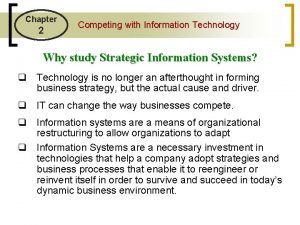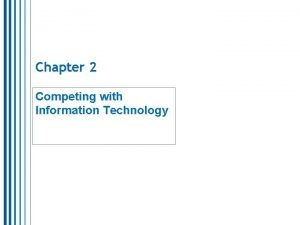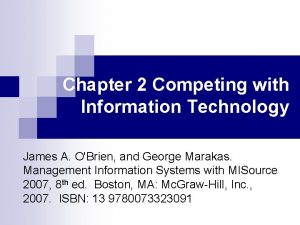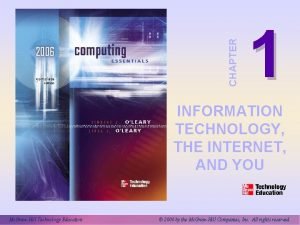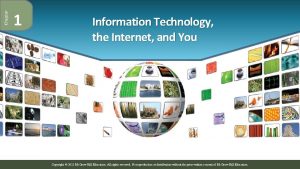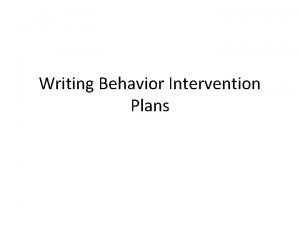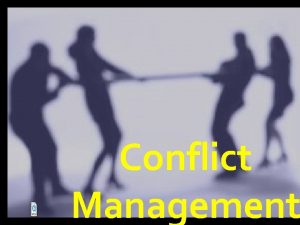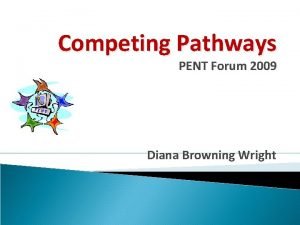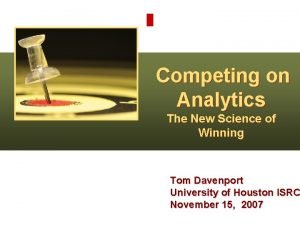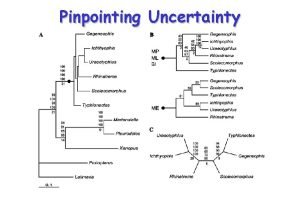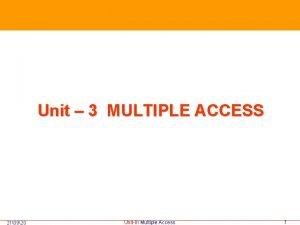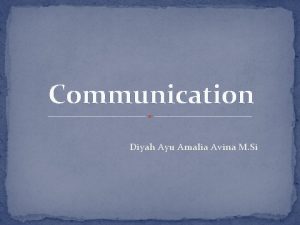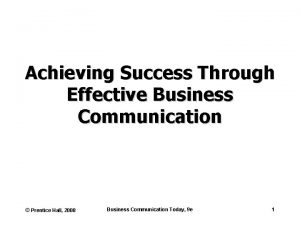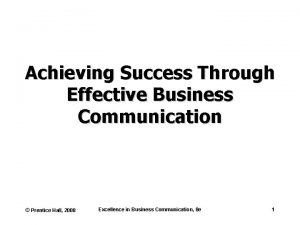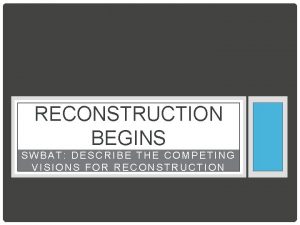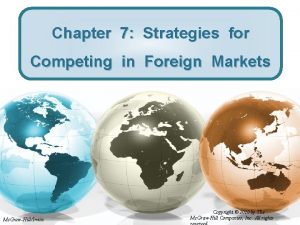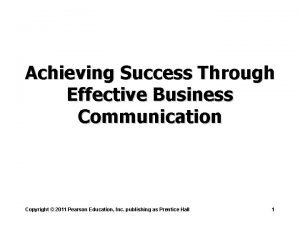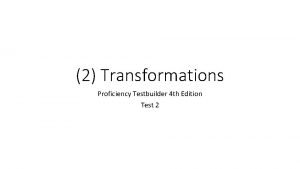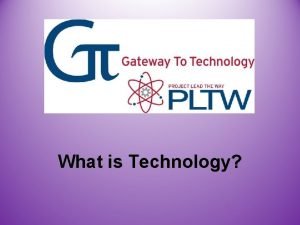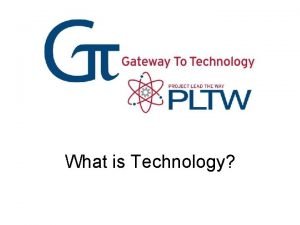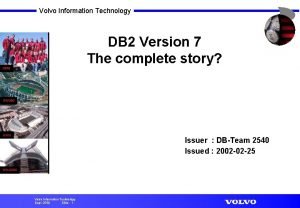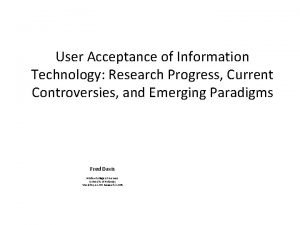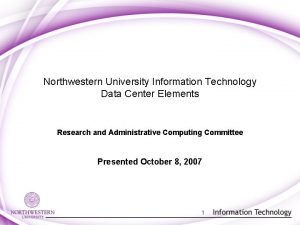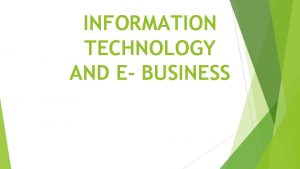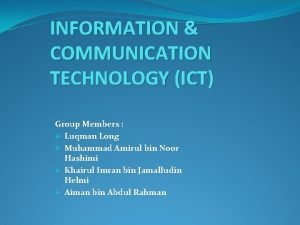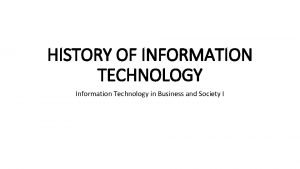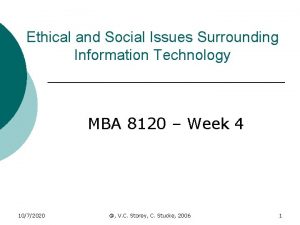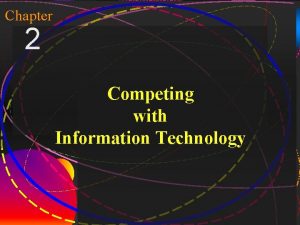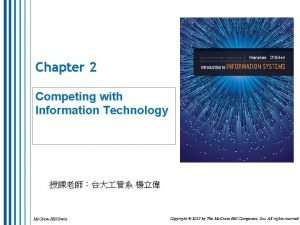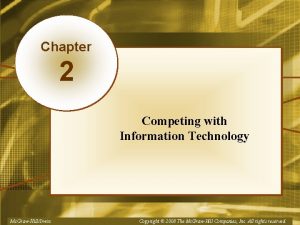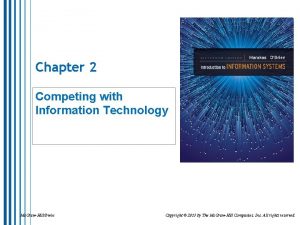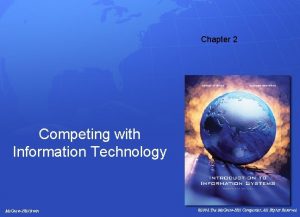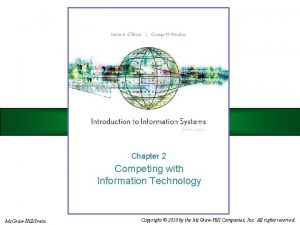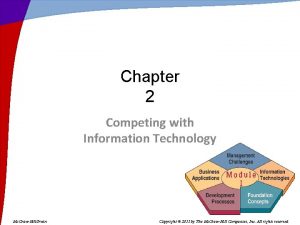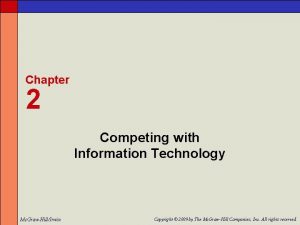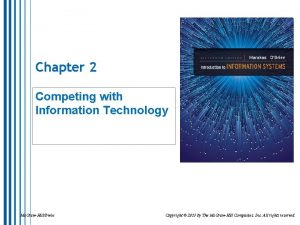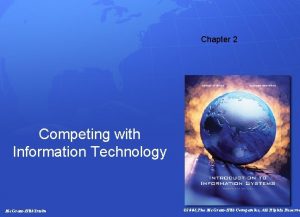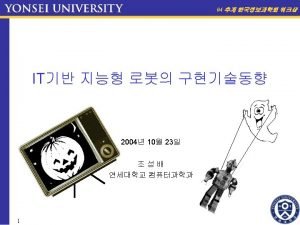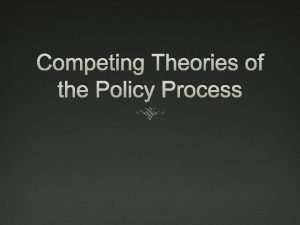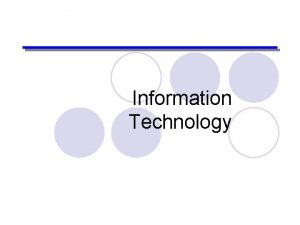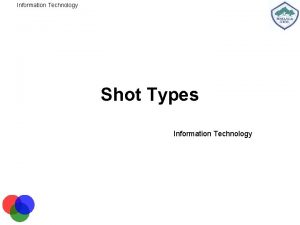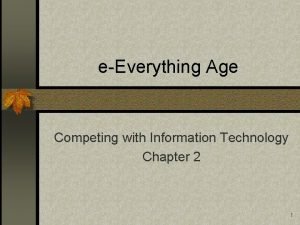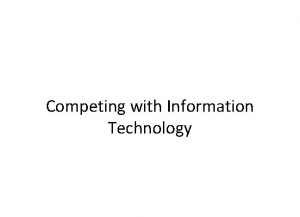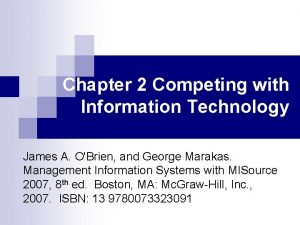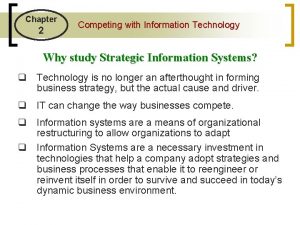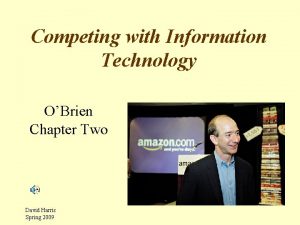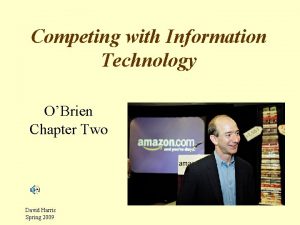Chapter 2 Competing with Information Technology Mc GrawHillIrwin







































- Slides: 39

Chapter 2 Competing with Information Technology Mc. Graw-Hill/Irwin Copyright © 2011 by The Mc. Graw-Hill Companies, Inc. All rights reserved.

Learning Objectives • Identify several basic competitive strategies and explain how they use information technologies to confront the competitive forces faced by a business • Identify several strategic uses of Internet technologies and give examples of how they help a business to gain competitive advantages • Give examples of how business process reengineering frequently involves the strategic use of IT 2 -2

Learning Objectives • Identify the business value of using Internet technologies to become an agile competitor or form a virtual company • Explain how knowledge management systems can help a business gain strategic advantages 2 -3

Strategic IT • Technology is no longer an afterthought in business strategy, but the cause and driver • IT can change the way businesses compete – Vital competitive networks – Organizational renewal – Necessary investment • Integral to success 2 -4

Competitive Strategy Concepts • A strategic information system uses IT to help an organization… – Gain a competitive advantage – Reduce a competitive disadvantage – Meet other strategic enterprise objectives • What is Competitive Advantage? – Capability for advantage over competitive forces – Leading the industry in some identifiable way – Sustains profits above the industry average – Hard to maintain over a long period of time 2 -5

RWC 1: Quantify IT Risks and Value • IT is a business asset, like buildings and land • Quantify IT Value and Risks – How much would normal operations cost without IT systems? – How much would operations cost if the IT system goes down? • IT is investment not cost • Must align IT with company strategy 2 -6

Porter’s Five Forces of Competition • Rivalry of Competitors – Positive, natural, healthy • Threat of new entrants – Apple, TRS 80, Commodore, IBM, HP, Compaq, Gateway, Dell, Acer • Threat of substitutes – Salon shampoo vs Wal-Mart brand – VCR vs DVD vs Blu. Ray • Customer bargaining power – Buy from competitors or don’t buy • Suppliers bargaining power – Your competitor pays in days not weeks 2 -7

Competitive Forces and Strategies 2 -8

Five Competitive Strategies • Cost Leadership – Become low-cost producers – Help suppliers or customers reduce costs – Increase cost to competitors • Example: Priceline • Differentiation Strategy – Set a firm’s products apart from competitors’ – Focus on a particular segment or niche market • Example: Dell 2 -9

Competitive Strategies (continued) • Innovation Strategy – Unique products, services, or markets – Radical changes to business processes • Example: Dell • Growth Strategy – Expand company’s capacity to produce – Expand into global markets – Diversify into new products or services • Example: Wal-Mart 2 -10

Competitive Strategies (continued) • Alliance Strategy – Includes mergers, acquisitions, joint ventures, virtual companies – Customers, suppliers, competitors, consultants, and other companies • Example: Wal-Mart uses automatic inventory replenishment by supplier 2 -11

Using Competitive Strategies • Not mutually exclusive – One alone won’t usually fix the problem – Generally need a combination • Innovation not necessarily differentiated – Kindle v. i. Pad – MP 3 players vs i. Pod – Gateway made in US, relaxed office • Differentiation not necessarily innovative – Shipping more efficient but not different – Telecom companies compete 2 -12

Using IT to Implement Basic Strategies 2 -13

Implementing Competitive Strategies 2 -14

Other IT strategies 2 -15

Other Competitive Strategies • Lock in Customers and Suppliers – Deter them from switching to competitors • Create Switching Costs – Time, money, effort or inconvenience needed to switch to a competitor • Raise Barriers to Entry – Discourage or delay other companies from entering the market – Increase the technology or investment needed to enter 2 -16

Other Competitive Strategies • Build a strong IT department • Use IT to: – Take advantage of strategic opportunities – Improve efficiency of business practices – Develop products and services that would not be possible without a strong IT capability • Use IT to do more than automate a system, be creative 2 -17

Competitive Advantage can become Competitive Necessity 2 -18

Customer-Focused Business • Keep customers loyal – Anticipate their future needs – Respond to customer concerns – Provide top-quality customer service • Focus on customer value – Quality, not price, has become the primary determinant of value 2 -19

Providing Customer Value • Companies that consistently offer the best value from the customer’s perspective… – Track individual preferences – Keep up with market trends – Supply products, services, and information anytime, anywhere – Tailor customer services to the individual – Use Customer Relationship Management (CRM) systems to focus on the customer 2 -20

Building Customer Value via the Internet 2 -21

Value Chain and Strategic IS • Activities that add value – Primary processes – direct – Support processes – indirect 2 -22

Strategic Uses of IT • Gain a competitive differentiation – Products – Services – Capabilities • Somehow do things better – Just-in-time 2 -23

Business Process Reengineering • Called BRP or simply Reengineering – Radical – Seeks improvements • High potential • High risk • Important enabler of reengineering – IT – Process teams – Case managers 2 -24

Role of Information Technology • Major role – Increase process efficiencies – Improves communication – Facilitates collaboration 2 -25

RWC 2: Running a Business on Smartphones • CPS Energy – Smartphones with digital cameras – Cut response time – Reduced inventory • Lloyd’s Construction – Smartphones with GPS – Mobile productivity software – Low cost – High return 2 -26

BPR Versus Business Improvement 2 -27

Cross-Functional Processes • Reengineered with… – Enterprise resource planning software – Web-enabled electronic business and commerce systems 2 -28

Reengineering Order Management 2 -29

Strategies for Becoming an Agile Company • Presents products as solutions to problems – Can price as a solution not cost to produce • Cooperates with customers, suppliers and competitors – Brings products to market as quickly and costeffectively as possible • Thrives on change and uncertainty – Responds to changing customer expectations • Leverages people and knowledge – Provides incentives for responsibility, adaptability, and innovation 2 -30

How IT Helps a Company be Agile 2 -31

Creating a Virtual Company • A virtual company uses IT to link… – – People Organizations Assets Ideas • Inter-enterprise information systems link… – – Customers Suppliers Subcontractors Competitors 2 -32

A Virtual Company 2 -33

Virtual Company Strategies 2 -34

Building a Knowledge-Creating Company • A knowledge-creating company or learning organization… – Consistently creates new business knowledge – Disseminates it throughout the company – Builds it into its products and services 2 -35

Knowledge Management • Explicit Knowledge – Data, documents, and things written down or stored in computers • Employee handbook • Tacit Knowledge – The “how-to” knowledge in workers’ minds – Most important information • Successful knowledge management – Rewards sharing – Makes better use of knowledge 2 -36

Knowledge Management Techniques 2 -37

RWC 3: Trading Securities • Investment companies rely on technology to gain competitive advantage • One-second delay can be costly • Wall Street – Fewer floor traders – New alternative exchanges and ecommunications networks 2 -38

RWC 4: Reinventing IT • • • Reliable and excellent IT services Innovative solutions Create new products and services New business models Lower cost Highest possible profit margins 2 -39
 Competing with information technology
Competing with information technology Competing with information technology
Competing with information technology Competing with information technology
Competing with information technology Competing with information technology
Competing with information technology Information technology chapter 3
Information technology chapter 3 Chapter 1 information technology the internet and you
Chapter 1 information technology the internet and you Chapter 1 information technology the internet and you
Chapter 1 information technology the internet and you Intervention
Intervention Ten thousand airline reservation stations are competing for
Ten thousand airline reservation stations are competing for Accommodating teddy bear
Accommodating teddy bear Competing pathways chart
Competing pathways chart Competing with analytics
Competing with analytics Competing behaviour pathway
Competing behaviour pathway Analysis of competing hypotheses template
Analysis of competing hypotheses template A network using csma/cd has a bandwidth of 10mbps
A network using csma/cd has a bandwidth of 10mbps Lesson 4 competing for colonies
Lesson 4 competing for colonies Competing messages communication barriers
Competing messages communication barriers Diyah ayu amalia avina
Diyah ayu amalia avina Lesson 4 competing for colonies
Lesson 4 competing for colonies Competing messages communication barriers
Competing messages communication barriers Competing messages communication barriers
Competing messages communication barriers The competing visions of reconstruction
The competing visions of reconstruction Two drawbacks of a think local act local
Two drawbacks of a think local act local Competing messages communication barriers
Competing messages communication barriers Competing behavior pathway example
Competing behavior pathway example Competing for advantage
Competing for advantage John has hinted that he doesn't wish to remain in the group
John has hinted that he doesn't wish to remain in the group Positive impacts of material technology
Positive impacts of material technology Science and technology
Science and technology Volvo information technology ab
Volvo information technology ab User acceptance of information technology
User acceptance of information technology Ict conclusion
Ict conclusion Similarities of media information and technology literacy
Similarities of media information and technology literacy Northwestern university information technology
Northwestern university information technology 5 disadvantages of information technology
5 disadvantages of information technology Introduction to information technology
Introduction to information technology Luqman long
Luqman long Information technology history timeline
Information technology history timeline Fluency with information technology
Fluency with information technology Issues surrounding information privacy
Issues surrounding information privacy
